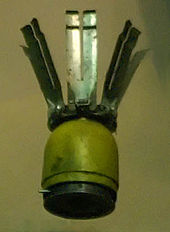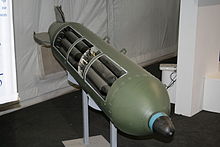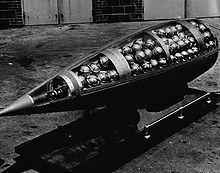A cluster munition is a form of air-dropped or ground-launched explosive weapon that releases or ejects smaller submunitions. Commonly, this is a cluster bomb that ejects explosive bomblets that are designed to kill personnel and destroy vehicles. Other cluster munitions are designed to destroy runways or electric power transmission lines, disperse chemical or biological weapons, or to scatter land mines. Some submunition-based weapons can disperse non-munitions, such as leaflets.Because cluster bombs release many small bomblets over a wide area, they pose risks to civilians both during attacks and afterwards. During attacks, the weapons are prone to indiscriminate effects, especially in populated areas. Unexploded bomblets can kill or maim civilians and/or unintended targets long after a conflict has ended, and are costly to locate and remove.Cluster munitions are prohibited for those nations that ratify the Convention on Cluster Munitions, adopted in Dublin, Ireland in May 2008. The Convention entered into force and became binding international law upon ratifying states on 1 August 2010, six months after being ratified by 30 states;[1] currently, a total of 112 states had signed the Convention and 83 of those have ratified it
[spoiler][/spoiler]Types Modern cluster bombs and submunition dispensers are often multiple-purpose weapons, containing mixtures of anti-armor, anti-personnel, and anti-materiel munitions. The submunitions themselves may also be multi-purpose, such as combining a shaped charge, to attack armour, with a fragmenting case, to attack infantry, material, and light vehicles. Modern multipurpose munitions may also have an incendiary effect.Recently submunition-based weapons have been designed that deploy smart submunitions, using thermal and visual sensors to locate and attack particular targets, usually armored vehicles. Weapons of this type include the US CBU-97 sensor-fuzed weapon, first used in combat during Operation Iraqi Freedom, the 2003 invasion of Iraq. Munitions specifically intended for anti-tank use may be set to self-destruct if they reach the ground without locating a target, theoretically reducing the risk of unintended civilian deaths and injuries. Although smart submunition weapons are many times more expensive than standard cluster bombs, which are cheaper and simpler to manufacture, far fewer smart submunitions are required for defeating dispersed and mobile targets in an area, offsetting this cost. On the basis that they should not cause the indiscriminate area effects or unexploded ordnance risks of cluster munitions, these submunitions are not classified as cluster munitions under the definition of the weapon enshrined in international law by the Convention on Cluster Munitions. Incendiary cluster bombs are intended to start fires, just as conventional incendiary bombs (also called firebombs). They are specifically designed for this purpose, with submunitions of white phosphorus or napalm, and they often include anti-personnel and anti-tank submunitions to hamper firefighting efforts.[citation needed] When used in cities they have often been preceded by the use of conventional explosive bombs to break open the roofs and walls of buildings to expose flammable contents to the incendiaries. One of the earliest examples is the so-called Molotov bread basket first used by the Soviet Union in the Winter War of 1939-40. This type of munition was extensively used by both sides in the strategic bombings of World War II. Bombs of this type were used to start firestorms or conflagrations in cases such as the bombing of Dresden in World War II and the firebombing of Tokyo. In some modern bombs, submunitions are used to deliver a highly combustible thermobaric aerosol, which is subsequently ignited, resulting in a high pressure explosion. Anti-personnel cluster bombs use explosive fragmentation to kill troops and destroy soft (unarmored) targets. Along with incendiary cluster bombs, these were among the first forms of cluster bombs produced by Germanyduring World War II. They were famously used during the Blitz with delay and booby-trap fusing to hamper firefighting and other damage-control efforts in the bombed areas. They were also used with a contact fuze when attacking entrenchments. These weapons were most widely used during the Vietnam War when many thousands of tons of submunitions were dropped on Laos, Cambodia and Vietnam Most anti-armor munitions contain shaped charge warheads to pierce the armor of tanks and armored fighting vehicles. In some cases, guidance is used to increase the likelihood of successfully hitting a vehicle. Modern guided submunitions, such as those found in the U.S. CBU-97, can use either a shaped charge or an explosively formed penetrator. Unguided shaped-charge submunitions are designed to be effective against entrenchments that incorporate overhead cover. To simplify supply and increase battlefield effectiveness by allowing a single type of round to be used against nearly any target, submunitions that incorporate both fragmentation and shaped-charge effects are produced. Anti-runway submunitions such as the British JP233 are designed to penetrate concrete before detonating, allowing them to shatter and crater runway surfaces. In the case of the JP233, the cratering effect is achieved through the use of a two-stage warhead that combines a shaped charge and a conventional bulk explosive charge. The shaped charge penetrates the surface of the runway while the bulk explosive charge detonates under the surface which makes the crater bigger. This explosion also shatters the surface. This effect, combined with theanti-personnel mines which may be deployed in addition to the Anti-runway, can make repairs more difficult.[citation needed] When submunition-based weapons are used to disperse mines, their submunitions do not detonate immediately, but behave like conventional land mines that detonate later. The submunitions usually include a combination ofanti-personnel and anti-tank mines. Since such mines usually lie on exposed surfaces, the anti-personnel forms, such as the US Area Denial Artillery Munition normally deploy tripwires automatically after landing to make clearing the minefield more difficult. In order to avoid rendering large portions of the battlefield permanently impassable, and to minimize the amount of mine-clearing needed after a conflict, scatterable mines used by theUnited States are designed to self-destruct after a period of time from 4 to 48 hours. The internationally agreed definition of cluster munitions being negotiated in the Oslo Process may not include this type of weapon, since landmines are already covered in other specific international instruments. During the 1950s and 1960s, the United States and Soviet Union developed cluster weapons designed to deliver chemical weapons. The Chemical Weapons Convention of 1993 banned their use. Six nations declared themselves in possession of chemical weapons. The US and Russia are in the process of destroying their stockpiles, although they have received extensions for the full destruction, not having completed the destruction of their chemical weapons stockpiles by 2007, as the Treaty had originally intended. An anti-electrical weapon, the CBU-94/B, was first used by the U.S. in the Kosovo War in 1999. These consist of a TMD (Tactical Munitions Dispenser) filled with 202 BLU-114/B "Soft-Bomb" submunitions. Each submunition contains a small explosive charge that disperses 147 reels of fine conductive fiber of either carbon or aluminum-coated glass. Their purpose is to disrupt and damage electric power transmission systems by producing short circuits in high-voltage power lines and electrical substations. On the first attack, these knocked out 70% of the electrical power supply in Serbia. There are reports that it took 500 people 15 hours to get one transformer yard back on line after being hit with these weapons.[citation needed] The LBU-30 is designed for dropping large quantities of propaganda leaflets from aircraft. Enclosing the leaflets within the bomblets ensures that the leaflets will fall on the intended area without being dispersed excessively by the wind. The LBU-30 consists of SUU-30 dispensers that have been adapted to leaflet dispersal. The dispensers are essentially recycled units from old bombs. The LBU-30 was tested at Eglin Air Force Base in 2000, by an F-16 flying at 20,000 feet (6,100 m).
A basic cluster bomb consists of a hollow shell and then two to more than 2,000 submunitions or bomblets contained within it. Some types are dispensers that are designed to be retained by the aircraft after releasing their munitions. The submunitions themselves may be fitted with small parachute retarders or streamers to slow their descent (allowing the aircraft to escape the blast area in low-altitude attacks)

Incendiary
Anti-personnel
Anti-tank
Anti-runway

Mine-laying
Chemical weapons

Anti-electrical
Leaflet dispensing
